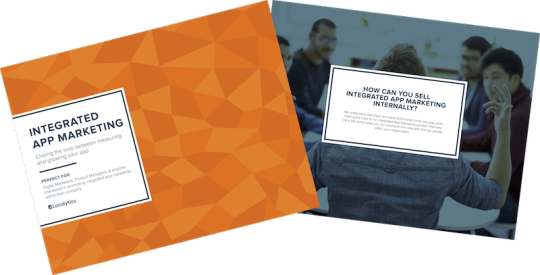
Your goal is simple: to grow your app substantially and measurably by providing value to the end user.
How you accomplish this can be equally as simple, or equally as difficult, depending on the analytics and marketing platform you choose to use.
A system of point solutions might seem like it offers the best of what each system has to offer, but it limits your ability to:
- Create a new user acquisition strategy that has a higher success rate & ROI over time
- Gather the most important & accurate data about your users
- Use analytics to drive targeted & personalized marketing
- Track the success of your app messaging & marketing campaigns
- Tackle big issues like user abandonment & churn rates
In our latest whitepaper, we cover the key differences between Disparate App Marketing (DAM) solutions and Integrated App Marketing (IAM) solutions. Here are some insights:
1. Sophisticated (and ROI-informed) user attribution
Competition for app user attention is staggering – the number of apps now in the App Store is incredible, and there are now so many point-solution apps that users have their pick of which they use for each task throughout their day.
So it’s up to you to put together a winning new user acquisition strategy. A solid user acquisition plan goes beyond App Store Optimization and reliance on search engines to display your app. It leverages IAM solutions that know which acquisition sources attract customers with the highest lifetime value (LTV) and know what type of in-app messaging customers are likely to engage with.
2. Personalized app marketing
Successful app marketing today is not only focused on how to acquire app users, but it is also intrinsically linked to whether you can provide a high-quality and consistent user experience. Targeted push messages can double app open rates, triple app conversion rates and increase app retention by 2-3x compared to generic blasted push messages, definitely proving that personalizing your app messaging to the user is the best way to boost your numbers.
With a disparate app solution, you run the risk of not having enough data – or enough quality data – about your users to launch the right kind of campaigns. Moreover, you can’t feed the results of your messaging campaigns back into your app user analytics to get a sense of what marketing they find valuable and respond to.

3. Remarketing to users outside of the app
Mobile remarketing will give app marketers the opportunity to bring back indecisive or churned customers with highly targeted ads outside of the app, or to upsell to existing users – all of which is only possible using an IAM solution.
Those users who were about to convert but didn’t? Or the ones who only used your app once? Bring them back into the fold. Personalized ads that already exist on the web will now exist on mobile with the ability to retarget customers based on their in-app behavior and profile data. But in order to do this right, you need the analytics foundation in place that informs custom campaigns and user need.
4. Omni-channel app marketing
Apps are everywhere: on TVs, set-top boxes, watches – even thermostats are all calling themselves the home of the app today. Chances are your product is being used on the web, offline, and on mobile devices. By default, your app strategy is already omni-channel. No matter the platform, you need to be engaging the user. With an IAM, you have the user data trail and marketing capabilities needed to run cross-channel campaigns smoothly, and without human err. You don’t run the risk of hitting data gaps, or losing track of valuable user information.
5. Predicting churn
Apps that engage users are the ones who have higher retention, LTV and total mobile ROI – because they’re the apps that users love. But sometimes engagement tactics fail, and you’re faced with a subset of users who are at risk of churning. Finding and retaining these users is too difficult and time-consuming to do manually, but an IAM with predictive app marketing is able to predict churn risks for you. Predictive app marketing uses all of the data you have about your customers, plus all of the ways they interact with your app, to predict customer behavior and proactively engage them with personalized experiences before you lose them.

This article was syndicated from Business 2 Community: 5 Things You Can Only Do With Integrated App Analytics & Marketing
More Technology & Innovation articles from Business 2 Community:




